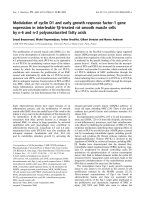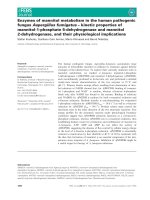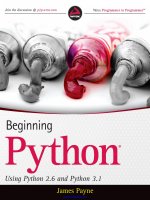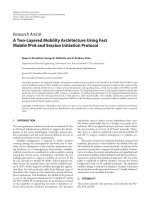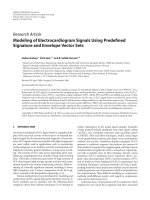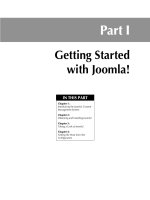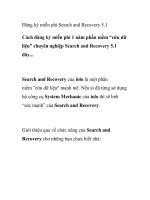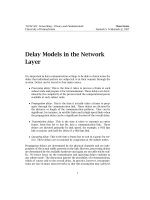Beginning Python Using Python 2.6 and Python 3.1 pot
Bạn đang xem bản rút gọn của tài liệu. Xem và tải ngay bản đầy đủ của tài liệu tại đây (5.55 MB, 628 trang )
Wrox Programmer to Programmer™
Join the discussion @ p2p.wrox.com
Using Python 2.6 and Python 3.1
Beginning
Python
®
James Payne
www.it-ebooks.info
Get more out of
wrox.com
Programmer to Programmer
™
Interact
Take an active role online by participating in our
P2P forums @ p2p.wrox.com
Wrox Online Library
Hundreds of our books are available online
through Books24x7.com
Wrox Blox
Download short informational pieces and code
to keep you up to date and out of trouble!
Join the Community
Sign up for our free monthly newsletter at
newsletter.wrox.com
Browse
Ready for more Wrox? We have books and
e-books available on .NET, SQL Server, Java,
XML, Visual Basic, C#/ C++, and much more!
Contact Us.
We always like to get feedback from our readers. Have a book idea?
Need community support? Let us know by e-mailing
www.it-ebooks.info
Beginning Python®: Using Python 2.6 and Python 3.1
Introduction . . . . . . . . . . . . . . . . . . . . . . . . . . . . . . . . . . . . . . . . . . . . . . .xxvii
Part I: Dipping Your Toe into Python
Chapter 1: Programming Basics and Strings . . . . . . . . . . . . . . . . . . . . . . . . . . 3
Chapter 2: Numbers and Operators . . . . . . . . . . . . . . . . . . . . . . . . . . . . . . . 15
Chapter 3: Variables — Names for Values . . . . . . . . . . . . . . . . . . . . . . . . . . . 31
Part II: Python Language and the Standard Library
Chapter 4: Making Decisions 51
Chapter 5: Functions 71
Chapter 6: Classes and Objects 93
Chapter 7: Organizing Programs 111
Chapter 8: Files and Directories 127
Chapter 9: Other Features of the Language 143
Chapter 10: Building a Module 157
Chapter 11: Text Processing 189
Part III: Putting Python to Work
Chapter 12: Testing 207
Chapter 13: Writing a GUI with Python 227
Chapter 14: Accessing Databases 239
Chapter 15: Using Python for XML 265
Chapter 16: Network Programming 287
Continues
www.it-ebooks.info
Chapter 17: Extension Programming with C 337
Chapter 18: Numerical Programming 367
Chapter 19: An Introduction to Django 387
Chapter 20: Web Applications and Web Services 407
Chapter 21: Integrating Java with Python 481
Part IV: Appendices
Appendix A: Answers to the Exercises 515
Appendix B: Online Resources 549
Appendix C: What’s New in Python 3.1 553
Appendix D: Glossary 559
Index 569
www.it-ebooks.info
Beginning
Python
®
www.it-ebooks.info
www.it-ebooks.info
Beginning
Python®
Using Python 2.6 and Python 3.1
James Payne
Wiley Publishing, Inc.
www.it-ebooks.info
Beginning Python®: Using Python 2.6 and Python 3.1
Published by
Wiley Publishing, Inc.
10475 Crosspoint Boulevard
Indianapolis, IN 46256
www.wiley.com
Copyright © 2010 by Wiley Publishing, Inc., Indianapolis, Indiana
Published simultaneously in Canada
ISBN: 978-0-470-41463-7
Manufactured in the United States of America
10 9 8 7 6 5 4 3 2 1
No part of this publication may be reproduced, stored in a retrieval system or transmitted in any form or by any
means, electronic, mechanical, photocopying, recording, scanning or otherwise, except as permitted under Sections
107 or 108 of the 1976 United States Copyright Act, without either the prior written permission of the Publisher, or
authorization through payment of the appropriate per-copy fee to the Copyright Clearance Center, 222 Rosewood
Drive, Danvers, MA 01923, (978) 750-8400, fax (978) 646-8600. Requests to the Publisher for permission should be
addressed to the Permissions Department, John Wiley & Sons, Inc., 111 River Street, Hoboken, NJ 07030, (201)
748-6011, fax (201) 748-6008, or online at />Limit of Liability/Disclaimer of Warranty: The publisher and the author make no representations or warranties
with respect to the accuracy or completeness of the contents of this work and specifically disclaim all
warranties, including without limitation warranties of fitness for a particular purpose. No warranty may be
created or extended by sales or promotional materials. The advice and strategies contained herein may not
be suitable for every situation. This work is sold with the understanding that the publisher is not engaged in
rendering legal, accounting, or other professional services. If professional assistance is required, the services of a
competent professional person should be sought. Neither the publisher nor the author shall be liable for
damages arising here from. The fact that an organization or Web site is referred to in this work as a citation
and/or a potential source of further information does not mean that the author or the publisher endorses the
information the organization or Web site may provide or recommendations it may make. Further, readers
should be aware that Internet Web sites listed in this work may have changed or disappeared between when
this work was written and when it is read.
For general information on our other products and services please contact our Customer Care Department
within the United States at (877) 762-2974, outside the United States at (317) 572-3993 or fax (317) 572-4002.
Wiley also publishes its books in a variety of electronic formats. Some content that appears in print may not be
available in electronic books.
Library of Congress Control Number: 2009936814
Trademarks: Wiley, the Wiley logo, Wrox, the Wrox logo, Wrox Programmer to Programmer, and related trade
dress are trademarks or registered trademarks of John Wiley & Sons, Inc. and/or its affiliates, in the United
States and other countries, and may not be used without written permission. Python is a registered trademark
of Python Software Foundation. All other trademarks are the property of their respective owners. Wiley
Publishing, Inc. is not associated with any product or vendor mentioned in this book.
www.it-ebooks.info
To my patient and loving wife, Whitney, who believed in me before I did. And to my parents,
Ronnie and Sharon Payne, who raised me to believe I could do anything I put my mind to, even
when I told them I wanted to be Santa Claus. For my brother, Ron, who read my work even when
it was bad, Dorjan, Eric, Clem, and Nick because they know things about me and
will tell them if I don’t include them.
www.it-ebooks.info
www.it-ebooks.info
About the Author
James Payne (Margate, FL) is Editor-in-Chief of Developer Shed, Inc. and has been writing and
programming since the age of seven years old. Proficient in many languages, he has written over
400 articles covering practically every major programming language. As a contractor, he develops
proprietary software for the financial industry using Python and likes to dabble in Django in his
spare time.
www.it-ebooks.info
www.it-ebooks.info
Credits
Executive Editor
Carol Long
Project Editor
Ed Connor
Technical Editor
Chris McAvoy
Production Editors
Amy Weintraub and Tim Tate
Copy Editor
Kim Cofer
Editorial Director
Robyn B. Siesky
Editorial Manager
Mary Beth Wakefield
Marketing Manager
David Mayhew
Production Manager
Tim Tate
Vice President and Executive Group Publisher
Richard Swadley
Vice President and Executive Publisher
Barry Pruett
Associate Publisher
Jim Minatel
Project Coordinator, Cover
Lynsey Stanford
Proofreaders
Scott Klemp and Kristy Eldredge, Word One
Indexer
Ron Strauss
Cover Image
© istockphoto.com/Frank_U
www.it-ebooks.info
www.it-ebooks.info
Acknowledgments
I would like to acknowledge the gang at Developer Shed: Jack and Jay Kim, whose constant hatred is an
inspiration, Charles Fagundes, who made me an editor and not just a writer, Keith Lee, who provided
coding support, and a special thanks to Jenny Ruggieri, who got me the job that got me this book. Lastly,
I’d like to thank all of the people that worked on the previous editions of this book for laying the
groundwork, and the Editors Carol Long, Jenny Watson, Ed Connor, and Chris McAvoy who helped me
meet deadlines no matter how much I didn’t want to.
I would also like to acknowledge Guido Von Rossum, without whom there would be no language to
write about.
www.it-ebooks.info
www.it-ebooks.info
Contents
Introduction xxvii
Part I: Dipping Your Toe into Python 1
Chapter 1: Programming Basics and Strings 3
How Programming is Different from Using a Computer 3
Programming is Consistency 4
Programming is Control 4
Programming Copes with Change 5
What All That Means Together 5
The First Steps 5
Installing Python 3.1 on Non-Windows Systems 6
Using the Python Shell 6
Beginning to Use Python — Strings 7
What is a String? 7
Why the Quotes? 7
Why Three Types of Quotes? 8
Using the print() Function 8
Understanding Different Quotes 9
Putting Two Strings Together 11
Joining Strings with the Print() Function 12
Putting Strings Together in Different Ways 12
Summary 13
Exercises 14
Chapter 2: Numbers and Operators 15
Different Kinds of Numbers 15
Numbers in Python 16
Program Files 18
Using the Different Types 19
Basic Math 21
Some Surprises 23
Using Numbers 24
Order of Evaluation 24
Number Formats 25
www.it-ebooks.info
Contents
xvi
Mistakes Will Happen 26
Some Unusual Cases 27
Summary 28
Exercises 29
Chapter 3: Variables — Names for Values 31
Referring to Data — Using Names for Data 31
Changing Data Through Names 33
Copying Data 33
Names You Can’t Use and Some Rules 34
Using More Built-in Types 34
Tuples — Unchanging Sequences of Data 34
Lists — Changeable Sequences of Data 37
Dictionaries — Groupings of Data Indexed by Name 39
Treating a String Like a List 41
Special Types 42
Other Common Sequence Properties 43
Referencing the Last Elements 43
Ranges of Sequences 44
Growing Lists by Appending Sequences 45
Using Lists to Temporarily Store Data 45
Working with Sets 46
Summary 47
Exercises 48
Part II: Python Language and the Standard Library 49
Chapter 4: Making Decisions 51
Comparing Values — Are They the Same? 51
Doing the Opposite — Not Equal 53
Comparing Values — Which One Is More? 54
More Than or Equal, Less Than or Equal 55
Reversing True and False 56
Looking for the Results of More Than One Comparison 56
How to Get Decisions Made 57
Repetition 60
How to Do Something — Again and Again 60
Stopping the Repetition 62
Handling Errors 65
Trying Things Out 65
www.it-ebooks.info
Contents
xvii
Summary 67
Exercises 69
Chapter 5: Functions 71
Putting Your Program into Its Own File 71
Functions: Grouping Code under a Name 73
Choosing a Name 75
Describing a Function in the Function 75
The Same Name in Two Different Places 76
Making Notes to Yourself 78
Asking a Function to Use a Value You Provide 79
Checking Your Parameters 81
Setting a Default Value for a Parameter—Just in Case 83
Calling Functions from within Other Functions 84
Functions Inside of Functions 86
Flagging an Error on Your Own Terms 87
Layers of Functions 88
How to Read Deeper Errors 88
Summary 89
Exercises 90
Chapter 6: Classes and Objects 93
Thinking About Programming 93
What is an Object? 93
Objects You Already Know 94
Looking Ahead: How You Want to Use Objects 95
Defining a Class 96
How Code Can Be Made into an Object 96
Objects and Their Scope 104
Summary 107
Exercises 108
Chapter 7: Organizing Programs 111
Modules 112
Importing a Module So That You Can Use It 112
Making a Module from Pre-existing Code 113
Using Modules — Starting with the Command Line 115
Changing How Import Works — Bringing in More 118
Packages 118
www.it-ebooks.info
Contents
xviii
Modules and Packages 120
Bringing Everything into the Current Scope 120
Re-importing Modules and Packages 121
Basics of Testing Your Modules and Packages 124
Summary 124
Exercises 125
Chapter 8: Files and Directories 127
File Objects 127
Writing Text Files 128
Appending Text to a File 129
Reading Text Files 130
File Exceptions 131
Paths and Directories 131
Exceptions in os
132
Paths 132
Directory Contents 135
Obtaining Information about Files 136
Renaming, Moving, Copying, and Removing Files 137
Example: Rotating Files 138
Creating and Removing Directories 140
Globbing 140
Summary 142
Exercises 142
Chapter 9: Other Features of the Language 143
Lambda and Filter: Short Anonymous Functions 143
Map: Short-Circuiting Loops 144
Decisions within Lists — List Comprehension 145
Generating Iterators for Loops 146
Special String Substitution Using Dictionaries 148
Featured Modules 149
Getopt — Getting Options from the Command Line 149
Using More Than One Process 152
Threads — Doing Many Things in the Same Process 154
Summary 156
Exercises 156
www.it-ebooks.info
Contents
xix
Chapter 10: Building a Module 157
Exploring Modules 157
Importing Modules 159
Finding Modules 159
Digging through Modules 160
Creating Modules and Packages 162
Working with Classes 163
Defining Object-Oriented Programming 163
Creating Classes 163
Extending Existing Classes 165
Finishing Your Modules 166
Defining Module-Specific Errors 166
Choosing What to Export 167
Documenting Your Modules 168
Testing Your Module 176
Running a Module as a Program 178
Creating a Whole Module 179
Installing Your Modules 183
Summary 187
Exercises 188
Chapter 11: Text Processing 189
Why Text Processing Is So Useful 189
Searching for Files 190
Clipping Logs 191
Sifting through Mail 192
Navigating the File System with the os Module 192
Working with Regular Expressions and the re Module 199
Summary 203
Exercises 204
Part III: Putting Python to Work 205
Chapter 12: Testing 207
Assertions 208
Test Cases and Test Suites 209
Test Fixtures 213
Putting It All Together with Extreme Programming 216
www.it-ebooks.info
Contents
xx
Implementing a Search Utility in Python 216
A More Powerful Python Search 222
Formal Testing in the Software Life Cycle 224
Summary 225
Chapter 13: Writing a GUI with Python 227
GUI Programming Toolkits for Python 228
Tkinter Introduction 229
Creating GUI Widgets with Tkinter 229
Resizing the Widget 230
Configuring Widget Options 231
Putting the Widgets to Work 231
Creating Layouts 232
Packing Order 233
Controlling Widget Appearances 233
Radio Buttons and Checkboxes 235
Dialog Boxes 236
Other Widget Types 237
Summary 238
Exercises 238
Chapter 14: Accessing Databases 239
Working with DBM Persistent Dictionaries 240
Choosing a DBM Module 240
Creating Persistent Dictionaries 241
Accessing Persistent Dictionaries 243
Deciding When to Use DBM and When to Use a Relational Database 245
Working with Relational Databases 245
Writing SQL Statements 247
Defining Tables 249
Setting Up a Database 250
Using the Python Database APIs 252
Downloading Modules 252
Creating Connections 253
Working with Cursors 253
Working with Transactions and Committing the Results 260
Examining Module Capabilities and Metadata 261
Handling Errors 261
Summary 262
Exercises 263
www.it-ebooks.info
Contents
xxi
Chapter 15: Using Python for XML 265
What Is XML? 265
A Hierarchical Markup Language 265
A Family of Standards 267
What Is a Schema/DTD? 268
What Are Document Models For? 268
Do You Need One? 268
Document Type Definitions 268
An Example DTD 268
DTDs Aren’t Exactly XML 270
Limitations of DTDs 270
Schemas 270
An Example Schema 270
Schemas Are Pure XML 271
Schemas Are Hierarchical 271
Other Advantages of Schemas 271
XPath 272
HTML as a Subset of XML 272
The HTML DTDs 273
HTMLParser 273
XML Libraries Available for Python 274
What Is SAX? 274
Stream-based 275
Event-driven 275
What Is DOM? 275
In-memory Access 275
Why Use SAX or DOM 275
Capability Trade-Offs 276
Memory Considerations 276
Speed Considerations 276
SAX and DOM Parsers Available for Python 276
xml.sax 276
xml.dom.minidom 277
Intro to XSLT 280
XSLT Is XML 280
Transformation and Formatting Language 280
Functional, Template-Driven 280
What Is lxml? 280
Element Classes 281
Adding Text to Elements 282
www.it-ebooks.info
Contents
xxii
Parsing with lxml 283
Parsing Files 284
Summary 285
Exercises 285
Chapter 16: Network Programming 287
Understanding Protocols 289
Comparing Protocols and Programming Languages 289
The Internet Protocol Stack 290
A Little Bit About the Internet Protocol 292
Sending Internet E-mail 293
The E-mail File Format 294
MIME Messages 295
Sending Mail with SMTP and smtplib 303
Retrieving Internet E-mail 305
Parsing a Local Mail Spool with mailbox 305
Fetching Mail from a POP3 Server with poplib 307
Fetching Mail from an IMAP Server with imaplib 309
Secure POP3 and IMAP 313
Webmail Applications Are Not E-mail Applications 313
Socket Programming 314
Introduction to Sockets 314
Binding to an External Hostname 316
The Mirror Server 317
The Mirror Client 318
SocketServer 320
Multithreaded Servers 321
The Python Chat Server 322
Design of the Python Chat Server 323
The Python Chat Server Protocol 323
The Python Chat Client 329
Single-Threaded Multitasking with select 331
Other Topics 332
Miscellaneous Considerations for Protocol Design 333
The Peer-to-Peer Architecture 333
Summary 334
Exercises 335
Chapter 17: Extension Programming with C 337
Extension Module Outline 338
Building and Installing Extension Modules 340
www.it-ebooks.info
Contents
xxiii
Passing Parameters from Python to C 342
Returning Values from C to Python 345
The LAME Project 346
The LAME Extension Module 350
Using Python Objects from C Code 363
Summary 366
Exercises 366
Chapter 18: Numerical Programming 367
Numbers in Python 368
Integers 368
Long Integers 369
Floating-point Numbers 369
Formatting Numbers 370
Characters as Numbers 373
Mathematics 374
Arithmetic 374
Built-in Math Functions 375
Complex Numbers 378
Arrays 380
The array Module 382
Summary 384
Exercises 384
Chapter 19: An Introduction to Django 387
What Are Frameworks and Why Would I Use One? 388
Other Features of Web Frameworks 388
Django — How It All Began 389
Installing Django 389
Understanding Django’s Architecture 390
Initial Project Setup 391
Creating a View 394
Working with Templates 396
Using Templates and Views 398
Models 401
Creating a Model: First Steps — Configure the Database Settings 401
Creating a Model: Creating an Application 403
Working with Models: Installation 404
Summary 405
Exercises 406
www.it-ebooks.info
